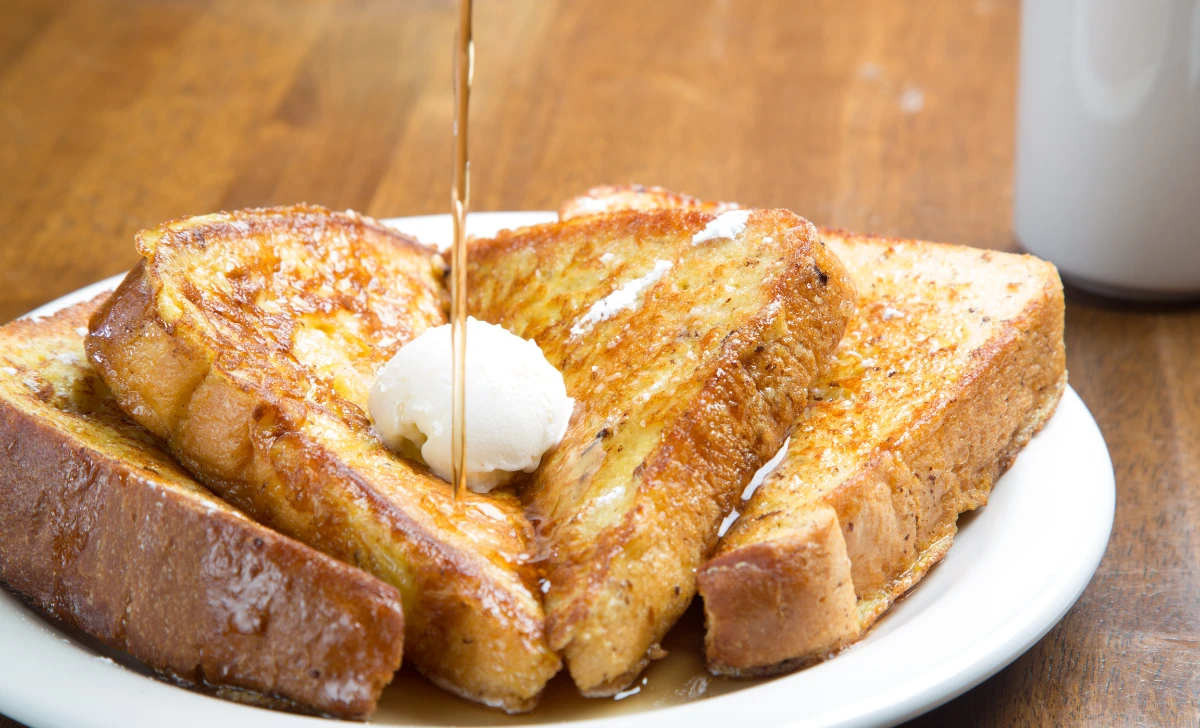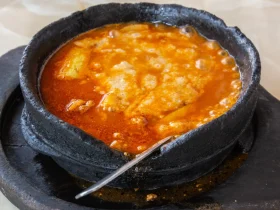Who doesn’t love a warm and comforting breakfast that’s both easy to make and utterly delicious? French toast is a classic morning favorite that never fails to satisfy those morning cravings. With its crispy exterior, custardy interior, and endless possibilities for toppings, French toast is a breakfast masterpiece. In this article, we’ll walk you through the steps to create the perfect French toast that will leave your taste buds dancing with joy.
[ez-toc]
History
The delightful breakfast treat we know today as French toast has a history as rich and diverse as its flavor. Originating from a simple practice of reusing stale bread, this dish has transformed over the centuries into a beloved morning staple. Let’s journey through time to uncover the intriguing history behind the evolution of French toast.
Ancient Origins
The roots of French toast can be traced back to ancient times, well before it was associated with France. The idea of using leftover bread dates back to ancient civilizations like the Egyptians, who found resourceful ways to repurpose old bread to avoid wastage. This practice gradually spread to various cultures across the globe.
Medieval Europe and “Poor Knights”
During the Middle Ages, French toast began to take shape in Europe. It was known by different names in different regions. In England, it was called “poor knights of Windsor,” while in France, it was referred to as “pain perdu,” meaning “lost bread.” The process involved soaking stale bread in a mixture of milk and eggs before frying it, creating a dish that was both filling and affordable.
A Renaissance of Flavor
As culinary techniques advanced, so did the art of making French toast. The dish evolved from a mere utilitarian use of leftover bread to a canvas for culinary creativity. The Renaissance era saw the inclusion of various spices, sugar, and even wine in the custard mixture, elevating the flavor profile and turning French toast into a dish fit for nobles and commoners alike.
18th and 19th Centuries: Global Adaptations
French toast transcended borders and oceans, taking on unique flavors in different parts of the world. In India, it became “Bombay toast,” infused with spices like cumin and turmeric. In Latin America, it’s known as “torrijas,” often soaked in syrup or honey.
20th Century: Mass Appeal
The 20th century brought convenience to French toast preparation. Cookbooks and advertisements from the mid-1900s introduced pre-sliced bread, making the dish even more accessible to households. French toast became a symbol of comfort and nostalgia, evoking memories of home-cooked breakfasts.
Creative Variations and Modern Twists
As the world became more connected, the culinary landscape expanded. Chefs and home cooks alike started experimenting with French toast, adding a plethora of creative twists. The inclusion of various bread types, toppings, and flavor combinations showcased the dish’s versatility.
French Toast Today: A Breakfast Masterpiece
In the present day, French toast has solidified its place as a beloved breakfast staple around the world. From quaint diners to high-end brunch spots, it’s a dish that appeals to all generations. The charm of French toast lies not only in its delectable taste but also in its ability to bring people together over a shared appreciation for simple yet satisfying food.
Time
| Step | Time |
|---|---|
| Prepping Your Bread | 5 minutes |
| Creating the Custard Mix | 5 minutes |
| Dipping and Soaking | 10 minutes |
| Cooking to Golden Perfection | 15 minutes |
| Toppings Galore | 5 minutes |
| Savory Variations | 5 minutes |
| Sweet Tooth Twists | 5 minutes |
| Serving Like a Pro | 5 minutes |
| Pairing with the Right Beverage | 5 minutes |
Ingredients
| Ingredients | Quantity for 2 Servings |
|---|---|
| Slices of Bread | 4 slices |
| Eggs | 2 |
| Milk | 1/2 cup |
| Vanilla Extract | 1 teaspoon |
| Cinnamon | 1/4 teaspoon |
| Salt | Pinch |
| Butter (for cooking) | 2 tablespoons |
Feel free to adjust the quantities based on personal preferences or serving size requirements.
Directions
Preparation:
1. Prepping Your Bread
- Begin by slicing your chosen bread into slices about an inch thick.
- If the bread is too fresh, leave it out for a few hours to slightly dry it out. This ensures it absorbs the custard mixture properly.
2. Creating the Custard Mix
- In a mixing bowl, whisk together 2 eggs, 1/2 cup of milk, 1 teaspoon of vanilla extract, 1/4 teaspoon of cinnamon, and a pinch of salt.
- Mix until the ingredients are well combined, and the mixture is slightly frothy.
3. Dipping and Soaking
- Heat a skillet or griddle over medium heat and add a pat of butter to melt.
- Dip each slice of bread into the custard mixture, allowing it to soak for a few seconds on each side. The goal is to achieve a balance between a moist interior and a crispy exterior.
Cooking:
4. Cooking to Golden Perfection
- Place the soaked bread slices onto the preheated skillet or griddle.
- Cook until the bottom side is golden brown, usually about 3-4 minutes.
- Flip the slices over and cook the other side until it’s also golden brown.
Finishing Touches:
5. Toppings Galore
- Once cooked, transfer the French toast to serving plates.
- Get creative with toppings: try fresh berries, sliced bananas, chopped nuts, or a dusting of powdered sugar.
6. Serving Like a Pro
- For a picture-perfect presentation, sprinkle a bit of powdered sugar over the top.
- Add a sprig of mint for an extra touch of elegance.
7. Pairing with the Right Beverage
- Enjoy your French toast with your preferred beverage. Coffee, orange juice, or even champagne can be delightful companions.
Equipment Required
Nutrition Information
| Nutrition Information | Per Serving |
|---|---|
| Serving Size | 2 slices |
| Calories | 320 |
| Total Fat | 14g |
| – Saturated Fat | 6g |
| Cholesterol | 200mg |
| Sodium | 330mg |
| Total Carbohydrates | 37g |
| – Dietary Fiber | 2g |
| – Sugars | 12g |
| Protein | 12g |
Please note that these values are approximate and can vary based on the specific brands of ingredients used and any variations or substitutions made to the recipe.
Tips
- Bread Choice: Opt for slightly thicker and sturdy bread like brioche, challah, or French bread. This helps the bread hold up well during soaking and cooking.
- Stale Bread: If you’re using fresh bread, leave it out overnight to slightly dry out. This prevents the bread from becoming too soggy during soaking.
- Custard Saturation: Avoid soaking the bread for too long in the custard mixture. A quick dip on both sides is sufficient to achieve the right texture.
- Heat Control: Use medium heat when cooking to ensure even browning without burning the exterior.
- Butter Patience: Allow the butter to fully melt on the skillet or griddle before placing the soaked bread slices. This helps prevent sticking and uneven cooking.
- Toppings Creativity: Experiment with various toppings to suit your taste preferences. From fresh fruit to whipped cream, there are endless options.
- Savory Exploration: Don’t hesitate to explore savory variations by skipping the sweet spices and adding your favorite herbs and spices to the custard mix.
- Overnight Prep: Prep the custard-soaked slices the night before and refrigerate. This speeds up the cooking process in the morning.
Pros & Cons
| Pros | Cons |
|---|---|
| ✅ Easy to make | ❌ Can be high in calories |
| ✅ Versatile toppings | ❌ May not be suitable for gluten-free diets |
| ✅ Comforting and delicious | ❌ Requires moderate cooking skills |
| ✅ Suitable for breakfast or brunch | ❌ Potential for over-soaking and soggy texture |
| ✅ Can be customized to dietary preferences | ❌ Not ideal for those with egg allergies |
Conclusion
As we wrap up our journey through the delightful world of French toast, it’s clear that this breakfast masterpiece offers more than just a sumptuous meal. It’s a warm hug on a plate, a canvas for creativity, and a simple pleasure that can transform any morning into a special occasion.
From the moment you slice your chosen bread to the satisfying sizzle as it cooks on the griddle, making French toast is a journey of culinary joy. The heavenly aroma of vanilla and cinnamon melding with crispy edges and custardy centers is enough to awaken your senses and set a smile on your face.
The beauty of French toast lies in its versatility. Whether you prefer sweet or savory, indulgent or health-conscious, there’s a French toast variation that suits your taste. From the classic powdered sugar and berries to the unexpected joy of a savory twist, the possibilities are as limitless as your imagination.
So why not embark on your own French toast adventure? Invite the warmth of comfort and the joy of creativity into your kitchen. Whether it’s a lazy weekend brunch or a quick weekday treat, crafting your own French toast masterpiece is an experience that promises to delight your taste buds and fill your heart.
Don’t wait—grab your ingredients, put on your apron, and dive into the world of homemade French toast. The sizzle, the aroma, the anticipation—it’s all part of the delicious journey waiting for you. Bon appétit! 🍞🍳🥞
Facts
- Fact 1: The Medieval “Poor Knights”
- 🏰 Did you know? French toast has a quirky medieval alias! In England, it was charmingly referred to as “poor knights of Windsor.” These knights weren’t guarding a castle; they were delighting in custard-soaked bread. 🍞🛡️
- Fact 2: Renaissance Flavor Explosion
- 🎭 Fancy a flavor twist? During the Renaissance, French toast got a major upgrade. Cinnamon and spices were the Elizabethan version of culinary bling, making each bite a delectable time-travel experience. 🍂✨
- Fact 3: French Toast Travels the Globe
- 🌍 Wanderlust on a plate! French toast transcended borders and got itself a first-class ticket around the world. Say “hola” to Spanish “torrijas” and “namaste” to Indian “Bombay toast.” A globetrotter indeed! 🌐🧳
- Fact 4: Caramelized Dreams
- 🔥 Sizzle and sweetness! The golden caramelization on French toast isn’t just a visual delight—it’s a symphony of flavor. The Maillard reaction at play turns simple ingredients into a taste masterpiece. 🎶🍯
- Fact 5: From Humble to Haute Cuisine
- 👑 Upscale meets everyday delight! French toast’s journey from “lost bread” to culinary elegance is like Cinderella’s story in the kitchen. It went from humble origins to adorning the tables of both royalty and common folk. 🍽️👑
FAQ’s
Can I use regular sandwich bread for French toast?
Absolutely! While artisanal bread adds an extra layer of flavor, regular bread works just fine.
Can I make French toast without eggs?
Yes, you can! Try using mashed bananas, yogurt, or even silken tofu as egg substitutes in the custard mix.
How can I prevent my French toast from getting too soggy?
Ensure your bread isn’t too fresh and don’t soak it in the custard for too long. A quick dip is all you need.
What’s the best way to reheat leftover French toast?
Pop it in a toaster or oven at a low temperature to bring back the crunchiness.
Can I freeze French toast?
Absolutely. Prepare a batch, let it cool, then freeze slices individually. Reheat in the toaster straight from the freezer.
Is it necessary to use vanilla extract in the custard mix?
Vanilla extract adds a delightful aroma and flavor, but you can omit it if preferred.
Can I use plant-based milk for a vegan version?
Certainly! Plant-based milk like almond, soy, or oat milk works well to create a vegan-friendly French toast.
Can I prepare the custard mixture the night before?
Yes, prepping the custard mixture the night before can save time in the morning. Just give it a quick stir before using.
What’s the secret to achieving a crispy exterior and soft interior?
Dip the bread quickly in the custard mix and cook over medium heat. This balance ensures the perfect texture.
Can I make French toast for a crowd?
Absolutely! Multiply the ingredients to match the number of servings needed and cook in batches. Keep the cooked slices warm in an oven set to low heat.












Leave a Review